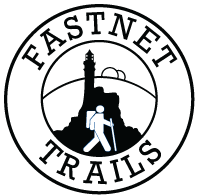Lisheenacrehig Loop Walk
| Type of Route | Arrows | Distance | Grading | Estimated Time |
| Loop Walk | Green | 8 km | Easy | 2 hours |
This 8km walk is mostly along quiet country roads. It is an easy walk which takes about 2 hours depending on the detours you take to explore the Points of Interest. It is a pleasant road walk through farmland taking in several old church sites and a historical pier.
Behind the former pub known as “The Cross House” lies the townland of Murrahin, where in the misty past an important battle was fought. It became known as the Battle of Murrahin and involved the O’Driscoll and O’Mahony clans.

The O’Driscolls, who had been in control of West Cork, were defeated here in the year 747 by the O’Mahonys, who had come from Bandon. The balance of control changed thereafter. In a different instance, an amber necklace found in a bog in Murrahin is now exhibited in a Dublin museum.
Take Note
🥾This walk is graded as Easy
🐕🦺Dogs must be kept on a lead at all times.
Walk Guide
Starting by the Trailhead (1) follow the footpath alongside the N71 with Kilcoe Church on your left.
After the church, you will see a colourful house which was once the Post Office. Now CROSS the N71 and continue up the hill past what was previously a bar called “The Cross House”. About 100 metres past the former pub you turn RIGHT (2) off the N71 into the townland of Murrahin. You will see a signboard explaining how, long ago, an important battle was fought here.
The road rises gently for a while as it weaves through open countryside then descends again to cross a small stream at a bend. There is a recently replanted forestry area on the right and quite soon you come to a road junction (3) where you need to turn back sharp LEFT.
From here on you are still following the GREEN arrows of the Lisheenacarrig Loop and you will also see the purple arrows of the Dereenard Loop which overlaps for the rest of the route.
Follow the road as it winds through Lisheenacrehig townland. Soon you reach a farm with buildings both sides of the road – keep going and you emerge into open country again, past a bungalow on the left, then reach a road junction (4) where you must turn LEFT.
This next section is about 1.5km and the road rises steadily and levels out until finally you will see the old Kilcoe Church of Ireland burial ground on the right. Take a few minutes to explore and then proceed south along the road to reach a major junction (5) with a saw mill on your right.
If you are running late you take a short cut back to the Trailhead by walking down the N71 to your left but otherwise CROSS with care and go STRAIGHT ON up the quiet side road, past houses, until you reach a cross roads (6) just after a large house on the left. Here you should turn LEFT and quite soon you come to the pre-famine church remains and old burial ground on the right. Take a few minutes to rest and explore this unique place.

Leaving the church behind follow the road downhill past the old boys’ school and round a few bends until you descend steeply to a cross roads (7) with a bridge over the gurgling stream. The route back to the Trailhead goes sharp LEFT up the hill beside the stream. If you have time, take a short detour downstream to explore the beautiful Roaring Water Quay. The pier enabled copper ore to be exported from the nearby mine workings.
From the cross roads, you ascend past a boat yard on your left to reach the Kilcoe Church and Trailhead in less than 10 minutes.
Kilcoe Church &
Graveyard

Winding veils round their heads, the women walked
Very little is known about this 12th century Church except that it was mentioned in a Papal document back in 1615 when it was referred to as a ruin. There is a piscina (basin) and water font to be seen here still. In the late 1840s the grounds were used for famine burials.
There are a number of chest tombs here too which were probably used to bury the local gentry. Local lore has it that these tombs were used for an illegal activity, the making of poteen, right up to the 1960’s.
These grounds are still in use as a graveyard with a couple of burials here each year.

